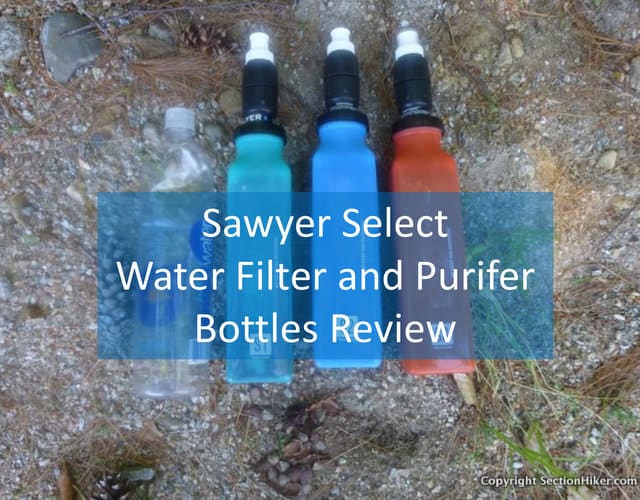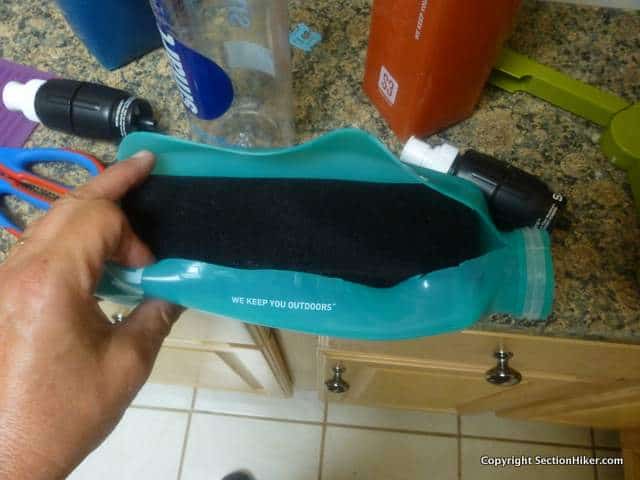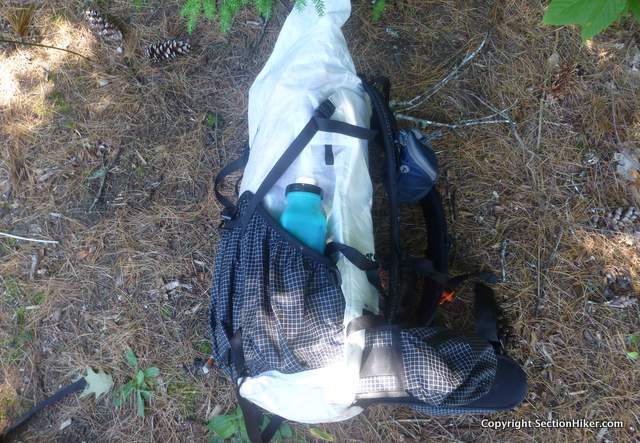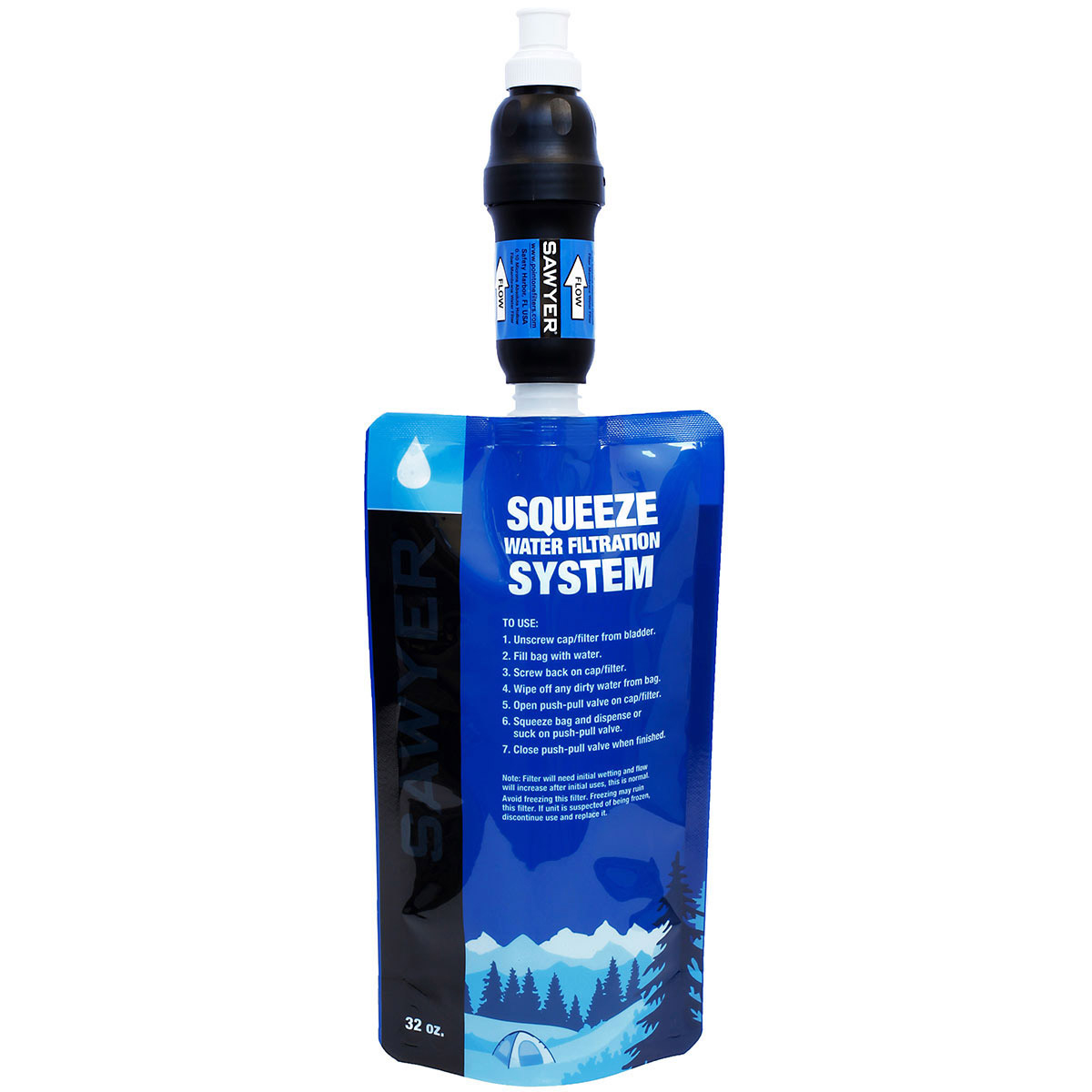
Sawyer’s Select Water Filter and Purifier Bottles combine a Sawyer’s 0.1 micron absolute hollow filter membrane filter (same as a Sawyer Mini, just smaller) with a foam purifier to remove contaminants found in fresh water. Labelled S1, S2, and S3, you can purchase different purifier bottles which remove different classes of contaminants. These are best used for emergency preparedness and not something you’d want to carry on a backpacking trip because they’re heavy, awkward to carry when assembled, and only produce low volumes of filtered or purified water. On the other hand, these Purifier bottles provide a level of protection against chemicals, pesticides, and heavy metals that goes beyond that provided by other microbiologically-oriented water purifiers like the MSR Guardian, General Ecology First Need, or Grayl Water Purifier Bottle.
Sawyer sells the bottles for three levels of contaminant protection, labeled S1, S2, and S3, as follows:
- S1: Bacteria, Protozoa, Chemicals, Pesticides
- S2: Bacteria, Protozoa, Chemicals, Pesticides, +Viruses
- S3: Bacteria, Protozoa, Chemicals, Pesticides, +Viruses, + Heavy Metals
How do you know which level of protection to get? It’s best to do some research about your local water conditions or travel destination to determine which contaminants you need to worry about. (The CDC is one of the best places to research these issues.) The S1 is generally adequate for agricultural areas; the S2 is suitable for international travel to undeveloped countries, while the S3 would be preferred in areas with heavy industry or mining.
Each water bottle unit comes with a foam-filled bottle, a screw-on filter, a syringe for back-flushing the filter, and a cleaning coupling. The screw-on water filter is responsible for removing bacteria and protozoa, like giardia and cryptosporidium, while the foam is responsible for removing smaller contaminants like viruses, chemicals, and heavy metals.
Unlike the filter, the foam in the bottles is not removable and has a limited lifetime of use, so you have to throw away the entire bottle after its lifetime expires (although the screw-on micro filter can continue to be used.) How do you know when that is? It’s not that obvious, because the unit will still process some water even after the internal foam becomes increasingly clogged.
- S1: 1600 uses, cost per use: $0.04
- S2: 800 uses, cost per use: $0.09
- S3: 400 uses, cost per use: $0.22

Each bottle has a white plastic cap and a black collar with holes in it. Do not remove the black collar ever! Doing so will compromise its seal with the bottle, leading to the possibility of leaks and cross-contamination. To fill the bottle with “dirty” water, remove the white cap, and pour it into the top opening up to the max fill line. You will have to alternately knead the bottle by squeezing it while pouring in water, to force out any air, and fully fill the unit. Be careful to keep track of the white cap, which is very easy to lose.
Next, screw on the black micro filter and vigorously squeeze the bottle in an alternating motion for 10 seconds. You can then pour the water in the bottle (with the filter still screwed on) into another “clean” container or drink it directly from the filter. If you drink from the filter, be careful not to touch your mouth to its top spout if it’s come in contact with “dirty” water.
While the bottle as a 32 oz capacity, you’ll only be able to fill it with half that much water since the rest of the volume is displaced by foam. Despite its fast processing time, you’ll need to repeat this process approximately 2-3 times for each liter of water processed. It’s a pretty slow process and would be pretty untenable in group situation when backpacking. Further, since each “use” only processes a fraction of the bottle’s total capacity, the costs per use listed above don’t equate with liters, but fractions of liters, making this a quite expensive solution.

When dry, each foam-filled water bottle weighs 7.7 oz, but this isn’t the weight you’d carry if you’re on foot because you can’t evacuate all the water trapped in the foam between uses. No matter how much you squeeze, the weight of a wet water bottle is 12-14 ounces, almost double its dry weight.

Assessment
I’ve used the Sawyer Select Filter and Purifier Bottles on trips and don’t feel that they’re well-suited for general backpacking or day hiking use because it takes multiple passes to process one liter of water. I also don’t like the idea of using a product that has to be thrown out completely after such limited use, even though you can keep using the included filter as a standalone product almost indefinitely. If all you need is to remove or neutralize microbiological contaminants like bacteria, protozoa, or viruses, I’d recommend using a conventional purifier like a Steripen or an MSR Guardian.
On the other hand, if you need to backpack internationally off the grid or need clean drinking water after a natural disaster, the Sawyer Select Purifier bottles offer an additional level of protection from chemicals, pesticides, and heavy metals like lead, mercury, and arsenic that few consumer-oriented mechanical, UV, or bottle-based water purifiers can match….at least according to Sawyer. This is a murky area where EPA recommendations, independent lab testing, and manufacturer marketing can and do obscure the complexity and limitations of test results. Buyer beware. Some of the test conditions used in laboratory settings don’t match reality.
While the Sawyer Select Purifier Bottles are an interesting application of foam technology to the problem of water purification and could be useful as a last resort in an emergency, nothing will beat having a supply of safe bottled water on-hand if you’re traveling internationally or need to survive a natural disaster.
Compare 3 Prices
-

 Hyperlite Mountain Gear$36.95View
Hyperlite Mountain Gear$36.95View -

 Amazon USUsed $28.95$45.99View
Amazon USUsed $28.95$45.99ViewAmazon.com Price: $45.99 (as of 04/18/2024 20:05 GMT-0400) Details
Product prices and availability are accurate as of the date/time indicated and are subject to change. Any price and availability information displayed on Amazon.com at the time of purchase will apply to the purchase of this product.
-

 Eastern Mountain Sports$45.99View
Eastern Mountain Sports$45.99View
Sawyer provided sample purifier bottles for this review. Published 2018.
SectionHiker is reader-supported. We only make money if you purchase a product through our affiliate links. Help us continue to test and write unsponsored and independent gear reviews, beginner FAQs, and free hiking guides. SectionHiker.com Backpacking Gear Reviews and FAQs
SectionHiker.com Backpacking Gear Reviews and FAQs
Does the bottle still work after you cut it open like that? (just joking) But seriously, I’m interested in the little black filter. How is the flow rate compared to the mini, which I find excruciatingly slow? Do the sell the filter separately?
They call it the “Micro” and it’s not sold separately and they have no plans to sell it as a separate product at this time. The flow rate is more comparable to the Squeeze filter than the mini. It’s really just a shorter Squeeze filter (same diameter).
Both the foam bottles and micro filters are now available separately
Seems like Sawyer would do well to sell the “micro” separately. Currently,too much overkill. Sounds like a good
compromise between a mini and squeeze.
They just announced that they will sell it separately.